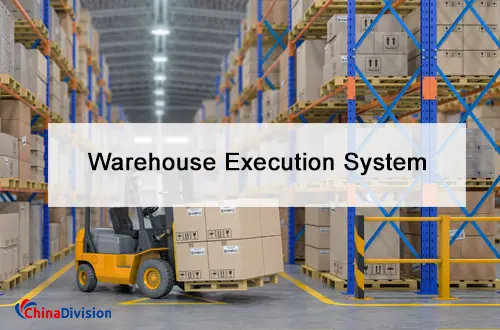The Difference Between a WES and a WMS in the Warehouse
B2B companies and cross-border e-commerce sellers face multiple challenges, including order fragmentation, shortened delivery cycles, and rising inventory costs. Optimizing warehouse operations through intelligent technology is key to overcoming growth bottlenecks.
Table of Contents
- What is a Warehouse Execution System (WES)?
- What are the core functions of a warehouse execution system?
- WES vs. WMS: Differences and Complementarities
- How to choose the right warehouse logistics software system for your business?
- See FAQs and answers to user pain points
- Chinadivision: Your global digital warehousing and logistics partner
This article will analyze the technical value, application scenarios, and selection strategies of a WES from the perspective of an international logistics service provider, and highlight its fundamental differences from a WMS (Warehouse Management System).
What is a Warehouse Execution System (WES)?
A Warehouse Execution System (WES) is an integrated software platform designed to coordinate and optimize various warehouse operations in real time, including inventory management, order processing, labor allocation, and equipment scheduling. It dynamically allocates warehouse tasks (such as picking, packing, sorting, and loading) by integrating multi-dimensional information such as order data, equipment status, and personnel efficiency, ensuring that each step is executed using the optimal route and at the lowest cost.

What are the core functions of a warehouse execution system?
Dynamic task scheduling
Automatically assign tasks based on order priority, equipment availability, and personnel skills;
Resource collaborative optimization
Coordinates the seamless integration of automated equipment such as AGVs, conveyors, and robotic arms with manual operations;
Real-time visual monitoring
Maps the entire warehouse process using digital twin technology, providing instant alerts for abnormalities;
Data-driven decision-making
Generates operational reports based on historical and real-time data to support continuous improvement.
WES vs. WMS: Differences and Complementarities
Many companies confuse WES and WMS (Warehouse Management System), but their roles are distinct:
The core objective of a WMS (Warehouse Management System) is to manage inventory, incoming and outgoing goods, and storage allocation, as well as space and basic processes (such as receiving and putting away goods).
The core objective of a WES (Warehouse Execution System) is to optimize real-time task execution and resource efficiency, scheduling equipment and optimizing processes.
A WMS (Warehouse Management System) focuses on long-term planning (such as inventory layout and batch management).
WES (Warehouse Execution System) focuses on short-term scheduling (such as minute-by-minute task allocation).
WMS (Warehouse Management System) technology focuses on rule engines and static policies.
WES (Warehouse Execution System) technology focuses on dynamic algorithms and real-time data processing.
WMS (Warehouse Management System) is primarily suitable for stable operations with high-volume, low-variety products.
WES (Warehouse Execution System) is primarily suitable for flexible operations with small-volume, high-variety products and high volatility.
Complementary relationship: WMS provides the "skeleton" (inventory and process framework), while WES injects the "soul" (dynamic execution capabilities). A warehouse management system (WMS) is more of a "planner," focusing on macro-level warehouse management, such as inventory records, inbound/outbound planning, and report generation. It typically processes operations on a batch basis and lacks real-time adaptability.
A warehouse execution system (WES) is an "executor," focusing on real-time operations and dynamic decision-making. It complements the WMS's shortcomings, enabling instant process adjustments and improved responsiveness in rapidly changing warehouse environments.
How to choose the right warehouse logistics software system for your business?
Choosing the right warehouse software system is a critical decision. Here are some suggestions based on Chinadivision's experience:
Evaluate business needs: Determine your warehouse size, order volume, and level of automation. A WES is essential for high-volume environments.
Integration capabilities: Ensure the system is compatible with existing ERP, WMS, or other tools to avoid data silos.
Real-time and scalability: Choose a solution that supports real-time data processing and is scalable to accommodate business growth.
Cost-benefit analysis: Consider the total cost of ownership (including implementation, training, and maintenance), not just the initial price. Supplier Support: Choose an international service provider like Chinadivision, which offers 24/7 technical support and customized services.
See FAQs and answers to user pain points.
How do you measure the return on investment (ROI) of WES?
Direct indicators: reduced order fulfillment costs, increased inventory turnover, and improved equipment utilization.
Indirect indicators: increased customer satisfaction, reduced return rates, and accelerated new market expansion.
How do you choose the right warehousing and logistics software system?
When selecting a warehousing system, consider the following factors:
Warehouse size and degree of automation
Order processing complexity and volatility
Requirement for real-time task scheduling and equipment control
Compatibility with existing ERP/WMS systems
Support for multi-channel order integration (such as e-commerce platforms and B2B orders)
Chinadivision: Your global digital warehousing and logistics partner
In today's increasingly competitive global landscape, WES is more than just a technical tool; it's a strategic asset for companies to build supply chain resilience. Chinadivision is committed to working with you to drive warehousing and logistics upgrades with intelligent execution systems, ensuring that every order reaches consumers around the world efficiently and accurately.
Want to learn more about warehouse automation, order fulfillment optimization, or international logistics strategies? Whether you're looking to upgrade your warehouse systems, expand your global presence, or streamline your procurement processes, Chinadivision can help you succeed with our professional services.





